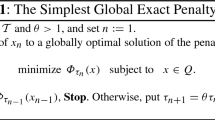Abstract
This paper identifies necessary and sufficient conditions for a penalty method to yield an optimal solution or a Lagrange multiplier of a convex programming problem by means of a single unconstrained minimization. The conditions are given in terms of properties of the objective and constraint functions of the problem as well as the penalty function adopted. It is shown among other things that all linear programs with finite optimal value satisfy such conditions when the penalty function is quadratic.
Similar content being viewed by others
References
D.P. Bertsekas and S.K. Mitter, “A descent numerical method for optimization problems with nondifferentiable cost functionals”,SIAM Journal on Control 11 (4) (1973) 637–652.
S.P. Chebotarev, “Variation of the penalty coefficient in linear programming problems”,Automation and Remote Control 34 (7) (1973) 102–107.
A.R. Conn, “Constrained optimization using a nondifferentiable penalty function”,SIAM Journal on Numerical Analysis 10 (1973) 760–784.
A.R. Conn and T. Pietrzykowski, “A penalty function method converging directly to a constrained minimum”, Research Rept. 73-11, Dept. of Combinatorics and Optimization, University of Waterloo (May 1973).
J.P. Evans, F.J. Gould and J.W. Tolle, “Exact penalty functions in nonlinear programming”,Mathematical Programming 4 (1) (1973) 72–97.
Y.M. Ermol'ev and N.Z. Shor, “On the minimization of nondifferentiable functions”,Kibernetica 3 (1) (1967) 101–102.
A.V. Fiacco and G.P. McCormick,Nonlinear programming: sequential unconstrained minimization techniques (Wiley, New York, 1968).
S. Howe, “New conditions for exactness of a simple penalty function”,SIAM Journal on Control 11 (2) (1973) 378–381.
B.W. Kort and D.P. Bertsekas, “Multiplier methods for convex programming”, in:Proceedings of 1973 IEEE decision and control conference, San Diego, Calif., Dec. 1973, pp. 428–432.
B.W. Kort and D.P. Bertsekas, “Combined primal dual and penalty methods for convex programming”,SIAM Journal on Control, to appear.
A.T. Kutanov, “Refining the solution of the linear programming problem in the method of penalty functions”,Automation and Remote Control 39 (4) (1970) 127–132.
D.G. Luenberger, “Control problems with kinks”,IEEE Transactions on Automatic Control AC-15 (1970) 570–575.
R.T. Rockafellar,Convex analysis (Princeton University Press, Princeton, N.J., 1970).
T. Pietrzykowski, “An exact potential method for constrained maxima”,SIAM Journal on Numerical Analysis 6 (2) (1969) 269–304.
N.O. Vil'chevskii, “Choosing the penalty coefficient in linear programming problems”,Automation and Remote Control 39 (4) (1970) 121–126.
W.I. Zangwill, “Nonlinear programming via penalty functions”,Management Science 13 (1967) 344–358.
Author information
Authors and Affiliations
Additional information
This work was performed while the author was with the Engineering-Economic Systems Department, Stanford University, Stanford, California.
Rights and permissions
About this article
Cite this article
Bertsekas, D.P. Necessary and sufficient conditions for a penalty method to be exact. Mathematical Programming 9, 87–99 (1975). https://doi.org/10.1007/BF01681332
Received:
Revised:
Issue Date:
DOI: https://doi.org/10.1007/BF01681332




